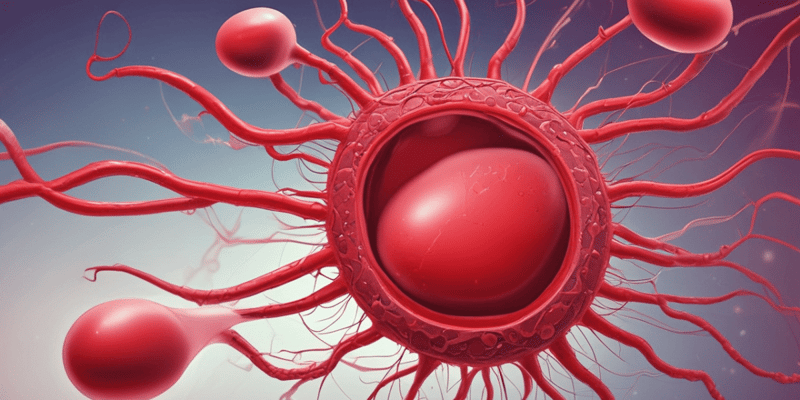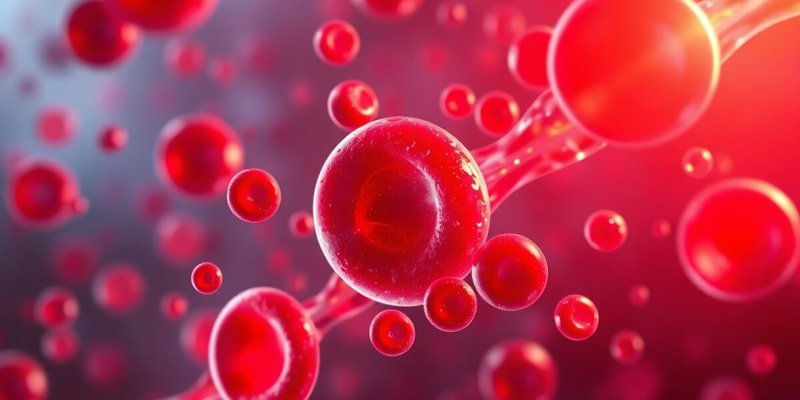Podcast
Questions and Answers
What is Factor III more commonly known as?
What is Factor III more commonly known as?
What is the main function of cofactors in the clotting mechanism?
What is the main function of cofactors in the clotting mechanism?
Which factor is regulated by proteolytic cleavage?
Which factor is regulated by proteolytic cleavage?
What is the outcome of the activation of Factor VIIa?
What is the outcome of the activation of Factor VIIa?
Signup and view all the answers
What is the time it takes to form a clot in the extrinsic pathway?
What is the time it takes to form a clot in the extrinsic pathway?
Signup and view all the answers
What is the trigger for the extrinsic pathway?
What is the trigger for the extrinsic pathway?
Signup and view all the answers
What is the role of Tissue Factor in the extrinsic pathway?
What is the role of Tissue Factor in the extrinsic pathway?
Signup and view all the answers
What is the sequential activation of serine proteases in the clotting cascade result in?
What is the sequential activation of serine proteases in the clotting cascade result in?
Signup and view all the answers
What is the result of Thrombin formation in the Coagulation Cascade?
What is the result of Thrombin formation in the Coagulation Cascade?
Signup and view all the answers
What is the role of the intrinsic pathway in the Coagulation Cascade?
What is the role of the intrinsic pathway in the Coagulation Cascade?
Signup and view all the answers
What is the major substrate of Thrombin?
What is the major substrate of Thrombin?
Signup and view all the answers
What is the result of the conversion of fibrin monomers to fibrin clot?
What is the result of the conversion of fibrin monomers to fibrin clot?
Signup and view all the answers
What is the role of Vitamin K in the Coagulation Cascade?
What is the role of Vitamin K in the Coagulation Cascade?
Signup and view all the answers
What is the function of Factor XIII in the Coagulation Cascade?
What is the function of Factor XIII in the Coagulation Cascade?
Signup and view all the answers
What is the purpose of the extrinsic pathway in the Coagulation Cascade?
What is the purpose of the extrinsic pathway in the Coagulation Cascade?
Signup and view all the answers
What is the function of the Vit-K dependent carboxylase?
What is the function of the Vit-K dependent carboxylase?
Signup and view all the answers
What is the normal value of Prothrombin Time (PT)?
What is the normal value of Prothrombin Time (PT)?
Signup and view all the answers
Which pathway is measured by the Partial Thromboplastin Time (PTT)?
Which pathway is measured by the Partial Thromboplastin Time (PTT)?
Signup and view all the answers
What is the normal value of Platelet Count?
What is the normal value of Platelet Count?
Signup and view all the answers
What is the result of a low Platelet Count?
What is the result of a low Platelet Count?
Signup and view all the answers
What is the purpose of the Coagulation Factor Assay?
What is the purpose of the Coagulation Factor Assay?
Signup and view all the answers
Which disease is associated with a prolonged Partial Thromboplastin Time (PTT)?
Which disease is associated with a prolonged Partial Thromboplastin Time (PTT)?
Signup and view all the answers
What is the purpose of the Platelet Function Assay?
What is the purpose of the Platelet Function Assay?
Signup and view all the answers
What does the mnemonic ❗️HELPFUL stand for?
What does the mnemonic ❗️HELPFUL stand for?
Signup and view all the answers
A mutation in which proenzyme would lead to uncontrolled blood clotting?
A mutation in which proenzyme would lead to uncontrolled blood clotting?
Signup and view all the answers
Which factor is directly activated by factor Xa?
Which factor is directly activated by factor Xa?
Signup and view all the answers
What is the primary cause of classical hemophilia A?
What is the primary cause of classical hemophilia A?
Signup and view all the answers
Which factor is necessary for the activation of factor X by factor IXa?
Which factor is necessary for the activation of factor X by factor IXa?
Signup and view all the answers
Warfarin inhibits the reduction of which vitamin?
Warfarin inhibits the reduction of which vitamin?
Signup and view all the answers
What is the result of an inability to form clotting factor complexes on cell membranes?
What is the result of an inability to form clotting factor complexes on cell membranes?
Signup and view all the answers
Which factor is directly activated by factor XIa?
Which factor is directly activated by factor XIa?
Signup and view all the answers
What is the primary cause of the bleeding disorder in the infant?
What is the primary cause of the bleeding disorder in the infant?
Signup and view all the answers
Why is the patient at risk for further clots?
Why is the patient at risk for further clots?
Signup and view all the answers
What is the function of Streptokinase?
What is the function of Streptokinase?
Signup and view all the answers
What is the role of Protein C in the body?
What is the role of Protein C in the body?
Signup and view all the answers
Why is the liver important in hemostasis?
Why is the liver important in hemostasis?
Signup and view all the answers
What is the function of Urokinase?
What is the function of Urokinase?
Signup and view all the answers
What is the effect of Warfarin on the body?
What is the effect of Warfarin on the body?
Signup and view all the answers
What is the role of PAI-1 in the body?
What is the role of PAI-1 in the body?
Signup and view all the answers
What is the function of t-PA in the body?
What is the function of t-PA in the body?
Signup and view all the answers
Why is the liver important for vitamin K absorption?
Why is the liver important for vitamin K absorption?
Signup and view all the answers
What is the effect of green leafy vegetables on Warfarin?
What is the effect of green leafy vegetables on Warfarin?
Signup and view all the answers
Study Notes
Blood Coagulation Cascade
- Intrinsic Pathway: triggered by internal stimuli, involves serine proteases that cleave the next proenzyme in the cascade, resulting in a rapid response
- Extrinsic Pathway: triggered by trauma, involves Tissue Factor (Factor III) and Factor VII, leading to the activation of Factor X and the coagulation cascade
Factors and Cofactors
- Factor II (Prothrombin): a key factor in the coagulation cascade
- Factor III (Tissue Factor): an integral membrane protein that does not require cleavage for activation
- Factor VII: binds to Tissue Factor to auto-catalyze its activation to VIIa
- Factor X: activated by Factor VIIa, leads to the formation of Thrombin (Factor IIa)
- Calcium (Ca2+): a cofactor that facilitates the clotting mechanism
- Protein C: a regulatory protein that is activated by proteolytic cleavage and inhibits the clotting cascade
Coagulation Cascade
- Tissue Factor and VIIa: key process involved in the initiation of blood coagulation in vivo
- Steps of Extrinsic Pathway:
- Trauma causes damaged tissues to present Tissue Factor (Factor III) to blood at injured site
- Factor VII binds to Tissue Factor to auto-catalyze its activation to VIIa
- Factor VIIa activates Factor X (to Xa) and Factor IX (to IXa)
- Activation of Factor IIa (Thrombin): leads to the formation of a "soft" clot, which is then cross-linked to form a "hard and stable" fibrin clot
Vitamin K Dependence
- Factors VII, IX, X, and II: require Vitamin K for their activation
- Vitamin K-dependent carboxylase: necessary for the activation of these factors
- HELPFUL MNEMONIC: 1972 → Factor X, II
Coagulation Assays
- Coagulation Factor Assay: measures the extrinsic pathway (III, VII) and common pathway (X, V, II, I)
- Prothrombin Time (PT): measures the extrinsic pathway
- Partial Thromboplastin Time (PTT): measures the intrinsic pathway
- Platelet Function Assay: measures platelet function and counts
Pathology and Disease
- Prolonged PT and aPTT: indicative of acquired or congenital deficiency of coagulation factors, Vitamin K deficiency, or liver disease
- Hemophilia A: results from a deficiency in Factor VIII
- Hemophilia B: results from a deficiency in Factor IX
- Von Willebrand Disease: a bleeding disorder characterized by a deficiency in von Willebrand Factor (vWF)
Studying That Suits You
Use AI to generate personalized quizzes and flashcards to suit your learning preferences.




